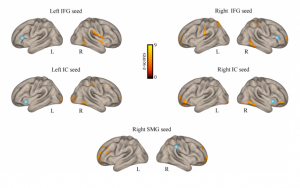Neurocognitive signatures of phonemic sequencing in expert backward speakers
Scientific Reports
Torres-Prioris, M. J., López-Barroso, D., Càmara, E., Fittipaldi, S., Sedeño, L., Ibáñez A., Berthier, M. L. & García, A. M. (2020). Neurocognitive signatures of phonemic sequencing in expert backward speakers. Scientific Reports 10, 10621. Online: https://go.nature.com/3iguHOL
Este estudio explora los correlatos cerebrales del habla inversa, capacidad que consiste en invertir el orden de los fonemas de las palabras sin alterar su identidad. Nuestros resultados sugieren que las habilidades expertas en habla inversa implican cambios volumétricos y de conectividad estructural y funcional no sólo en vías dorsales y ventrales implicadas canónicamente con el procesamiento fonológico, sino también en regiones de procesamiento asociativo-visual y de dominio general. Estos sustratos, por tanto, parecen cumplir un papel distintivo en un aspecto elemental del lenguaje humano: la capacidad de secuenciar fonemas.
Para acceder al artículo completo hacé click AQUÍ
Neurocognitive signatures of phonemic sequencing in expert backward speakers
Scientific Reports
Torres-Prioris, M. J., López-Barroso, D., Càmara, E., Fittipaldi, S., Sedeño, L., Ibáñez A., Berthier, M. L. & García, A. M. (2020). Neurocognitive signatures of phonemic sequencing in expert backward speakers. Scientific Reports 10, 10621. Online: https://go.nature.com/3iguHOL
Despite its prolific growth, neurolinguistic research on phonemic sequencing has largely neglected the study of individuals with highly developed skills in this domain. To bridge this gap, we report multidimensional signatures of two experts in backward speech, that is, the capacity to produce utterances by reversing the order of phonemes while retaining their identity. Our approach included behavioral assessments of backward and forward speech alongside neuroimaging measures of voxel-based morphometry, diffusion tensor imaging, and resting-state functional connectivity. Relative to controls, both backward speakers exhibited behavioral advantages for reversing words and sentences of varying complexity, irrespective of working memory skills. These patterns were accompanied by increased grey matter volume, higher mean diffusivity, and enhanced functional connectivity along dorsal and ventral stream regions mediating phonological and other linguistic operations, with complementary support of areas subserving associative-visual and domain-general processes. Still, the specific loci of these neural patterns differed between both subjects, suggesting individual variability in the correlates of expert backward speech. Taken together, our results offer new vistas on the domain of phonemic sequencing, while illuminating neuroplastic patterns underlying extraordinary language abilities.
To access the full paper please click HERE



